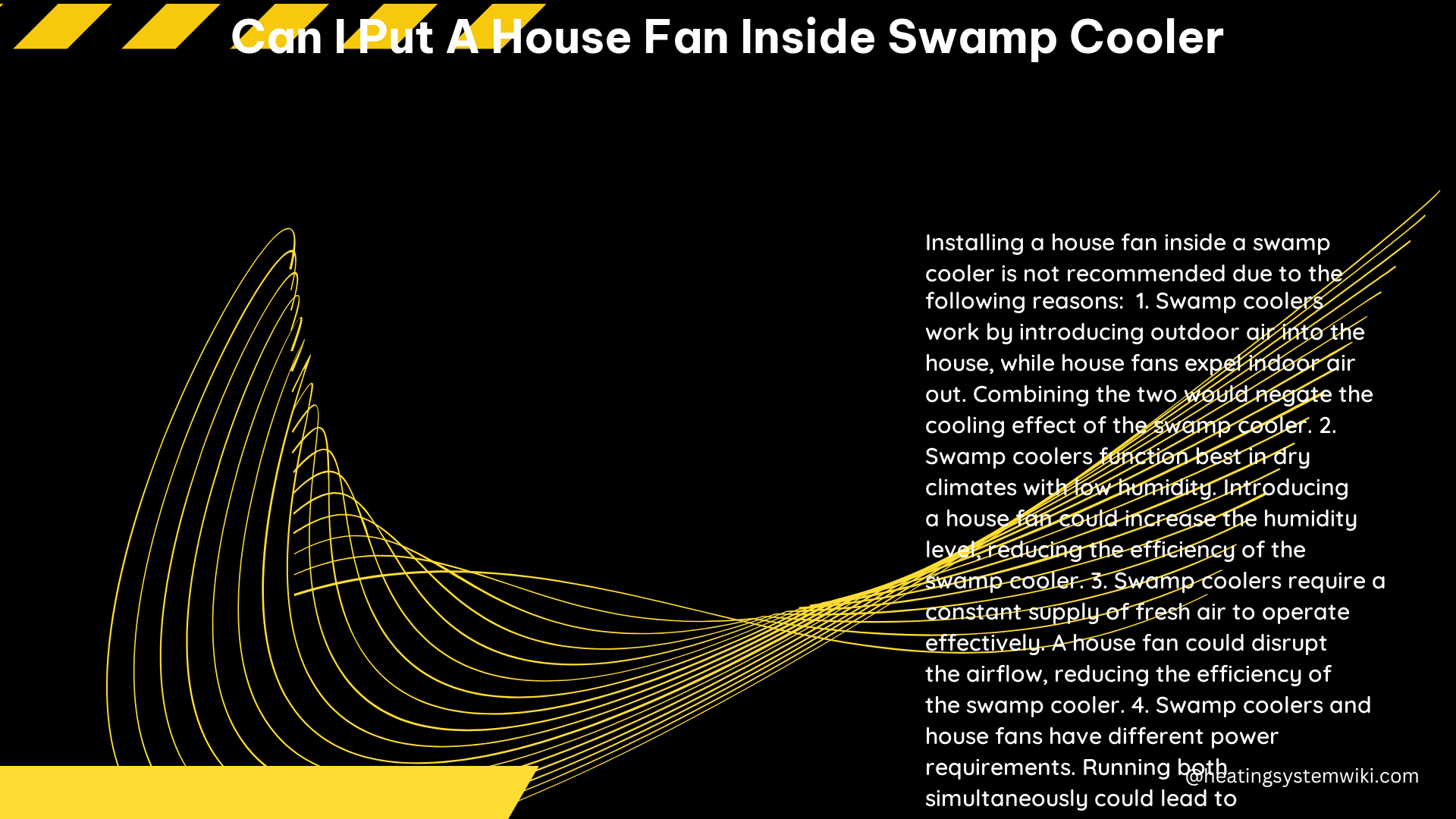Swamp coolers, also known as evaporative coolers, and house fans are two distinct cooling systems with different operating principles and optimal conditions. While it is technically possible to combine these systems, it is generally not recommended due to the potential for reduced efficiency and increased energy costs.
Understanding Swamp Coolers
Swamp coolers work by pulling in hot, dry air from the outside and passing it over water-soaked pads. As the air flows through the pads, the water evaporates, which cools the air. This cooled air is then distributed throughout the living space, either through ducts or directly from the unit.
The key factors that make swamp coolers effective are:
- Hot, Dry Climate: Swamp coolers work best in hot, arid regions where the air has low humidity. The evaporation process is more efficient in dry conditions.
- Water Availability: Swamp coolers require a constant supply of water to keep the pads saturated, typically around 3-5 gallons per hour of operation.
- Airflow: The fan in a swamp cooler must be powerful enough to draw in sufficient hot, dry air and distribute the cooled air throughout the space.
Understanding House Fans

House fans, on the other hand, are ventilation devices designed to exhaust hot indoor air and draw in cooler outdoor air through open windows and doors. They are typically installed in the attic or upper levels of a home and work by creating a pressure differential that facilitates air circulation.
The key factors that make house fans effective are:
- Hot, Humid Climate: House fans are more effective in hot, humid climates where the outdoor air is cooler than the indoor air, allowing for efficient heat exchange.
- Airflow: House fans must be sized appropriately for the square footage of the home to ensure adequate air circulation and cooling.
- Window/Door Placement: Proper placement of open windows and doors is crucial for house fans to effectively draw in cooler outdoor air and exhaust hot indoor air.
Combining Swamp Coolers and House Fans
While it is possible to run a swamp cooler and a house fan simultaneously, it is generally not recommended for the following reasons:
-
Conflicting Operating Conditions: Swamp coolers work best in hot, dry climates, while house fans are more effective in hot, humid climates. Running both systems together can result in reduced efficiency and higher energy costs.
-
Airflow Interference: The airflow patterns created by the swamp cooler and the house fan may interfere with each other, leading to suboptimal cooling performance.
-
Increased Humidity: The evaporative cooling process of the swamp cooler can increase the humidity levels in the home, which can reduce the effectiveness of the house fan in drawing in cooler outdoor air.
-
Potential Damage: Placing a house fan directly inside a swamp cooler could potentially cause damage to the fan or the swamp cooler itself, as the high-velocity airflow and moisture-rich environment may not be compatible with the house fan’s design.
Considerations for Replacing a Swamp Cooler with a House Fan
If you are considering replacing a swamp cooler with a whole house fan, it is essential to carefully evaluate your specific needs and circumstances. Some key factors to consider include:
- Climate and Humidity Levels: Assess the climate and humidity levels in your area to determine if a whole house fan is the most suitable cooling solution.
- Home Size and Layout: Ensure that the house fan you choose is appropriately sized for the square footage and layout of your home to provide effective cooling.
- Energy Efficiency: Compare the energy consumption and operating costs of a whole house fan versus a swamp cooler to determine the most cost-effective option.
- Consultation with Professionals: Consider consulting with a heating and cooling specialist to help you make an informed decision and ensure proper installation and integration of the new cooling system.
In summary, while it is technically possible to put a house fan inside a swamp cooler, it is generally not recommended due to the conflicting operating conditions and potential for reduced efficiency and increased energy costs. If you are considering replacing a swamp cooler with a whole house fan, it is crucial to carefully evaluate your specific needs and circumstances to ensure the most effective and energy-efficient cooling solution for your home.
References:
– Can I Change from a Swamp Cooler to a Whole House Fan?
– Evaporative Cooling and Air Conditioning: Can You Use Both?
– Can you use evaporative cooling indoors instead of AC?
– Why can’t a swamp cooler and a furnace be active at the same time?
